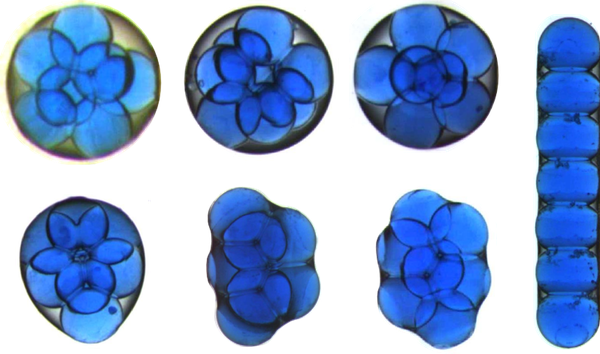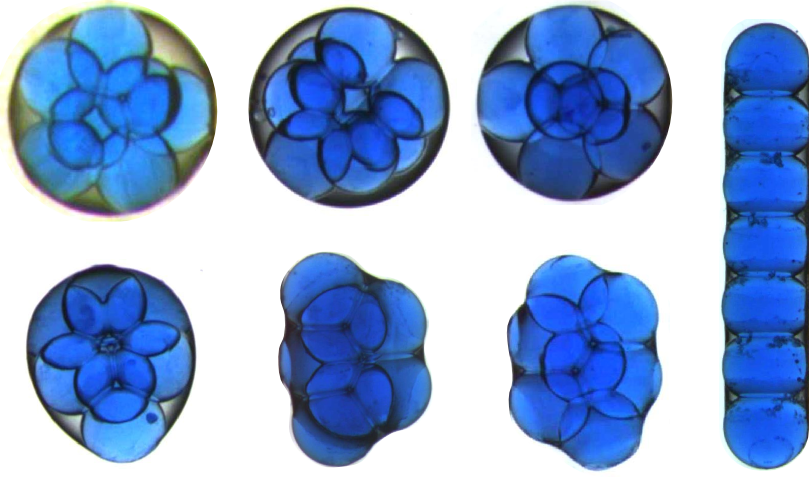Oil-Water Droplets Form Surprising Structures
In hopes of producing materials with new properties, researchers have created sub-millimeter-scale structures from collections of tiny, rigid particles floating in liquid. Now a team reports using water droplets trapped inside larger oil drops to produce a wider range of structures—including linear chains—with more ability to control them than was available in the past. The new water-oil clusters could eventually lead to advances in targeted drug delivery and other dreams of biotechnology.
For years, researchers have been coaxing rigid particles in fluids (colloids) to stick together into tiny clusters of various shapes, with the goal of making advanced materials by joining many clusters together. But there have been some limitations, says Jan Guzowski of the Polish Academy of Sciences (PAS) in Warsaw. A group of particles either settles into a single, consistent, close-packed state, or the cluster can form a variety of states whose configurations can’t be controlled by the experimenters.
Now Guzowski and his PAS colleague Piotr Garstecki have shown that clusters made from a given number of soft particles can form more than one configuration and that researchers can influence the final arrangement. The team hopes this variety of structures will be useful for new technologies.
Guzowski and Garstecki’s procedure was to combine three immiscible (nonmixing) fluids. First they injected an oily mixture of hydrocarbon liquids into a 150-micrometer-wide pipe. Next they injected into the oil a stream of blue-dyed water, which immediately separated into droplets as wide as the channel. The oil containing water droplets then flowed into a larger reservoir filled with a fluorocarbon solution, where the oil separated into larger drops, each containing between and water droplets. At this last stage, as the oil drops formed, the formerly linear arrangement of water droplets folded “in a very reproducible manner into a unique three dimensional structure with beautiful regular behavior,” says Guzowski. By varying the rate of flow and tilt angle of the channels, the team could manipulate the number of water droplets that appeared in each oil drop.
The researchers expected compact packing inside spherical oil drops because it’s the most stable, lowest-energy configuration. They saw these structures but were surprised to also see irregular arrangements that were not compact. The most extreme case was linear chains of droplets whose oil coating was tightly stretched, like a sock stuffed with tennis balls.
Guzowski says that these chains are completely new. “I was quite amazed when I first saw them under the microscope,” he says, because he expected linear chains to “either collapse into one [spherical] droplet or break into several droplets,” as occurs in a thin stream of water from a tap. The variety of configurations arose because the water droplets were often squeezed and distorted within their oil drop and unable to rearrange into a more spherical structure. The fact that the droplets are soft was key, the team says.
Guzowski and Garstecki observed the effects of two main parameters— , the number of droplets; and , the fraction of the oil drop’s volume occupied by the droplets. They found three regimes: At low and low , they saw close-packing as one might expect for a handful of confined spheres, and as was observed previously with hard colloids [1]. At intermediate and for five or more droplets, the oil drops were significantly deformed from a sphere. Finally, for above about they found stable, linear chains. To better understand the chains, Guzowski developed a computer model that confirmed their stability.
Researchers in this field hope that the control of droplet structures will enable advances from biotechnology to networking and computing. By controlling the placement of small amounts of fluid, for example, therapeutic drugs could be positioned and combined right where they’re needed. And droplets that self-assemble into regular lattice structures could form new types of tunable “photonic band-gap” materials that might be capable of directing different wavelengths of light in specific directions. This property could be a key feature for future optical switching, projection displays, and photonic computing.
“This work opens up new perspectives in the study of soft liquid droplets with multiple layers,” says Qian Chen of the University of Illinois at Urbana-Champaign. She says the results may also “potentially provide guidelines for designing tissue-like materials composed of similar soft building blocks.”
This research is published in Physical Review Letters.
–Ransom Stephens
Ransom Stephens is a physicist, writer, and technologist in Petaluma, California. His latest book is The Sensory Deception, a novel published by 47North.
References
- Y. Wang, Y. Wang, D. R. Breed, V. N. Manoharan, L. Feng, A. D. Hollingsworth, M. Weck, and D. J. Pine, “Colloids with Valence and Specific Directional Bonding,” Nature 491,51 (2012); V. N. Manoharan, M. T. Elsesser, and D. J. Pine, “Dense Packing and Symmetry in Small Clusters of Microspheres,” Science 301, 483 (2003).





